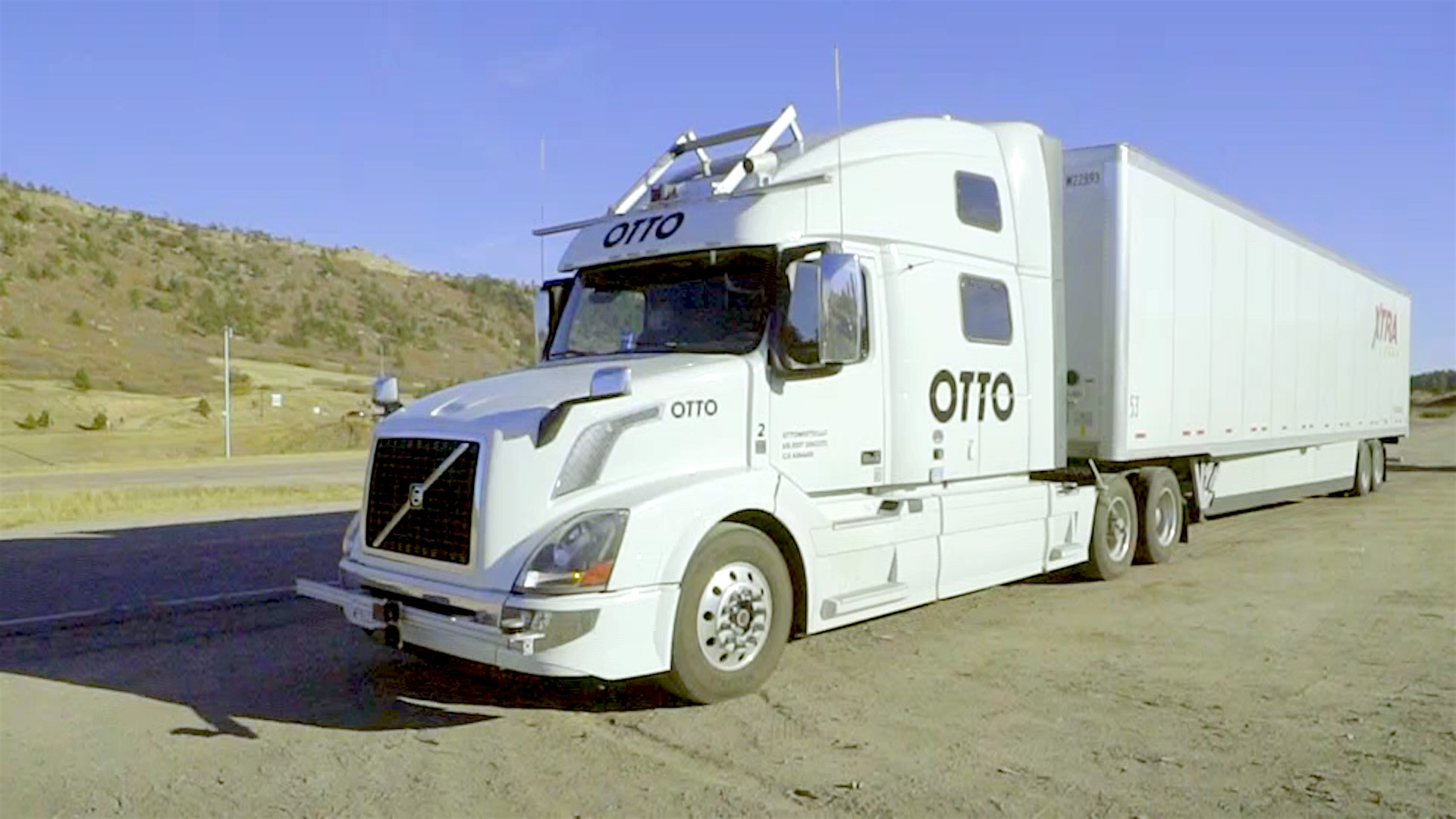Image: Embark
We often view automation through the lens of job losses, and understandably so: Some studies have predicted that robots will take about 40 percent of all jobs in the next two decades. That’s going to mean a lot of out-of-work people, but in the context of trucking, automation—and specifically autonomous vehicles—could be a godsend.Freight demands are up around the world, but there aren’t enough workers behind the wheel. Objectively, the solution seems simple: Just recruit more drivers, right? The thing is, the industry says literally nobody wants this job.“You can throw all the money in the world at them. Young people just don’t want to do it,” said Joe Rajkovacz, the director of governmental affairs and communications with the Western States Trucking Association, a US-based truckers’ trade group. In northern California, truckers working in some sectors that are partly funded by public money—for example, hauling mail or driving on certain construction sites—earn a prevailing wage of $56 an hour. Yet, Rajkovacz continued, “we have members begging for drivers.”That’s why all eyes are on the US government’s proposed legislation to regulate autonomous vehicles, namely the SELF DRIVE Act and AV START Act. The Teamsters Union, which represents many American truckers, cheered the exclusion of self-driving trucks from proposed regulations back in July. It’s using the threat of job losses as a rationale against self-driving trucks, even though police and security witnesses have said highly automated trucks would improve road safety.Protecting existing jobs, however, won’t be enough to solve trucking’s increasingly urgent staffing crunch. In 2016, US trucking had a shortage of 36,500 drivers, according to the American Trucking Associations’ Truck Driver Shortage Analysis report released last year. If current trends continue, that could mean a shortage of 174,000 drivers by 2026. Truckers’ average ages range between 49 and 52, depending on the sector.Of course, trucking is not alone. Shortages of skilled and unskilled labor in manual and blue-collar work have been well-documented in recent years. You’d think young people would jump at the chance to earn a good living, but blue-collar jobs have been trending downwards inverse to the rise of university degrees.“It’s this digital economy we live in,” Rajkovacz told me over the phone from his office in Upland, California. “How many young people want to do this? In all of these manual jobs, the pay is excellent but there’s shortages in all of them.” This labor crunch means there aren’t enough trucks to meet cargo-transportation demands, and that’s a real supply-chain predicament for even the biggest companies. North America depends mightily on freight transportation. The American trucking industry’s revenues totalled $676 billion in 2016.A growing scarcity of workers and freight capacity could also jeopardize a variety of lean-margin industries that depend on truckers for distribution, like the agriculture commodity market, and could eventually filter down to the sticker price of most items we buy.Even with trains moving freight around the country, though, trucks are still required for last-mile delivery.“Trucks aren’t going to go away,” said Rajkovacz. “If they’re not going away, and people don’t want to drive them, what are we going to do?”Automated and semi-autonomous trucks are being developed by a number of tech and automotive companies, such as Tesla’s Semi, Uber’s trucking arm, and Daimler’s and Peloton’s platooning technology. Late last year, autonomous semi truck maker Embark—which is currently testing partial (Level 2) autonomy—grabbed headlines by hauling high-end fridges across 650 miles while relying entirely on autopilot.On its site, Embark says self-driving trucks will make roads safer, goods cheaper, and that drivers will be able to use existing skills while developing new ones. Of course, these trucks won’t be entirely driverless for quite some time. For myriad safety reasons, a person will need to be in the driver’s seat even if they’re not actually driving.That doesn’t entirely solve the personnel problem, but it helps: In the past, truck drivers often travelled in teams, trading off between sleeping and driving, but automation may render that unnecessary. Rajkovacz, who worked as a single-truck owner-operator for 30 years, said he hated doing that because he was often paired with “idiots.” When autonomous trucking comes of age, it may be possible to have a single “driver” operate as a team with their automated vehicle.Also, “driving” an autonomous truck is actually pretty cool, and that may also attract some new blood. The trucking industry should learn from the innovations technology has spurred in other sectors and look to it to help solve some of trucking’s biggest woes, said Rajkovacz—“[because] it sure as hell can’t get any worse.”Get six of our favorite Motherboard stories every day by signing up for our newsletter .
This labor crunch means there aren’t enough trucks to meet cargo-transportation demands, and that’s a real supply-chain predicament for even the biggest companies. North America depends mightily on freight transportation. The American trucking industry’s revenues totalled $676 billion in 2016.A growing scarcity of workers and freight capacity could also jeopardize a variety of lean-margin industries that depend on truckers for distribution, like the agriculture commodity market, and could eventually filter down to the sticker price of most items we buy.Even with trains moving freight around the country, though, trucks are still required for last-mile delivery.“Trucks aren’t going to go away,” said Rajkovacz. “If they’re not going away, and people don’t want to drive them, what are we going to do?”Automated and semi-autonomous trucks are being developed by a number of tech and automotive companies, such as Tesla’s Semi, Uber’s trucking arm, and Daimler’s and Peloton’s platooning technology. Late last year, autonomous semi truck maker Embark—which is currently testing partial (Level 2) autonomy—grabbed headlines by hauling high-end fridges across 650 miles while relying entirely on autopilot.On its site, Embark says self-driving trucks will make roads safer, goods cheaper, and that drivers will be able to use existing skills while developing new ones. Of course, these trucks won’t be entirely driverless for quite some time. For myriad safety reasons, a person will need to be in the driver’s seat even if they’re not actually driving.That doesn’t entirely solve the personnel problem, but it helps: In the past, truck drivers often travelled in teams, trading off between sleeping and driving, but automation may render that unnecessary. Rajkovacz, who worked as a single-truck owner-operator for 30 years, said he hated doing that because he was often paired with “idiots.” When autonomous trucking comes of age, it may be possible to have a single “driver” operate as a team with their automated vehicle.Also, “driving” an autonomous truck is actually pretty cool, and that may also attract some new blood. The trucking industry should learn from the innovations technology has spurred in other sectors and look to it to help solve some of trucking’s biggest woes, said Rajkovacz—“[because] it sure as hell can’t get any worse.”Get six of our favorite Motherboard stories every day by signing up for our newsletter .
Advertisement
Advertisement

And it’s not like we have many other options for shipping goods across the country. Rail also has capacity problems. Heavier trains, as well as damaged and/or aging trains and tracks, are a recipe for disaster. Plus, in many places, passenger and freight trains share rails—and a growing demand for passenger rail means some tracks are already extremely busy. Amtrak partly blames its poor on-time performance on sharing track with freight trains.Read More: Even the Weed Industry Isn't Safe From Automation
Advertisement
